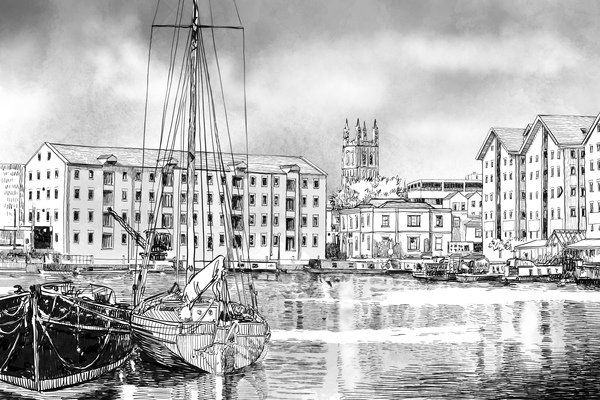Candidate: Gloucester Docks
Location: Gloucester, England
Category: The Great Place Award
Year: 2023
Other finalists in this category: Claypits Local Nature Reserve, Glasgow (winner) and Spanish City, Whitley Bay
Judges' comments:
“The revitalisation of Gloucester Docks is an example of successful publicly-led heritage regeneration. The Docks’ rich 200-year history has been showcased by retaining and enhancing its historic features, while also creating a new dynamic mixed-use quarter with a blend of commercial and civic uses. The Docks now form a major asset for the city to offer an enticing location to live, work, play and visit, with a resident community actively engaging in its upkeep.” - Francis Newton AoU, Great Place Lead Assessor
Introduction
Gloucester Docks represents a high-profile urban regeneration project which has been ongoing since the 1980s.
The Docks form Britain’s most inland port – Gloucester being located at a point where the inland waterway network and seagoing vessels converge. The Gloucester and Sharpness Ship Canal provides a safe route to the Severn Estuary – this stretching 16 miles from the Docks to Sharpness.
The Docks boast a rich 200-year history first opening in 1827 to become a hub of activity during the 19th and early 20th Centuries, with ships offloading cargos of wheat, barley, oats and maize to the warehouses prior to onward journey via barge and narrowboat to the Midlands. Small coasters and barge traffic continued to serve the Docks until the 1970s, after which they largely fell out of use.
The Docks are defined by their imposing brick-built warehouse structures these embracing the Main Basin, Victoria Dock, the Barge and the Gloucester and Sharpness Canal.
The Gloucester Docks Conservation Area was designated in 1968 an area of special architectural and historic interest which is considered worthy of preservation and enhancement. The area includes a total of 28 listed buildings of special architectural and historic interest, these including 13 listed warehouses, the Mariners Chapel, the Gloucester Lock and Dry Docks and Dock Company Offices.
Regeneration started during the 1980s with a pioneering move to save four of the listed warehouses, these being converted to commercial and residential use. However, the formation of the Gloucester Docks Heritage Urban Regeneration Company (GDHURC) in the early 2000s saw a further phase of development and regeneration, this being informed by the Gloucester Docks Draft Planning Guidance in 2006 and a masterplan prepared by Gillespies in 2009.
Over the past two decades, remaining warehouses have been subject to renovation to create residential apartments with offices, attractions including the National Waterways and Soldiers of Gloucestershire museums, bars, restaurants and pedestrianised public realm. Victoria Dock now serves as a marina for pleasure craft which includes residential moorings.
The regeneration of the Docks area has been further consolidated through infill development including residential flats, the Gloucestershire College Campus with further investment in public realm and striking public artwork. The Gloucester Quays retail outlet centre, formerly the Fielding and Platt Engineering Works, also opened in 2009, this incorporating old industrial buildings into its design.
*The extent of the nomination primarily relates to the historic docks and environs, i.e. the Gloucester Docks Conservation Area. However, for the purposes of the assessment, the former docks area extending to St Ann Way, which includes the Gloucester Quays Retail Outlet and the Gloucestershire College campus – these also forming the most recent phase in the regeneration of the docks, were also considered.
Thumbnail illustration of Gloucester Docks by David Rudlin AoU, Artist-in-Residence









